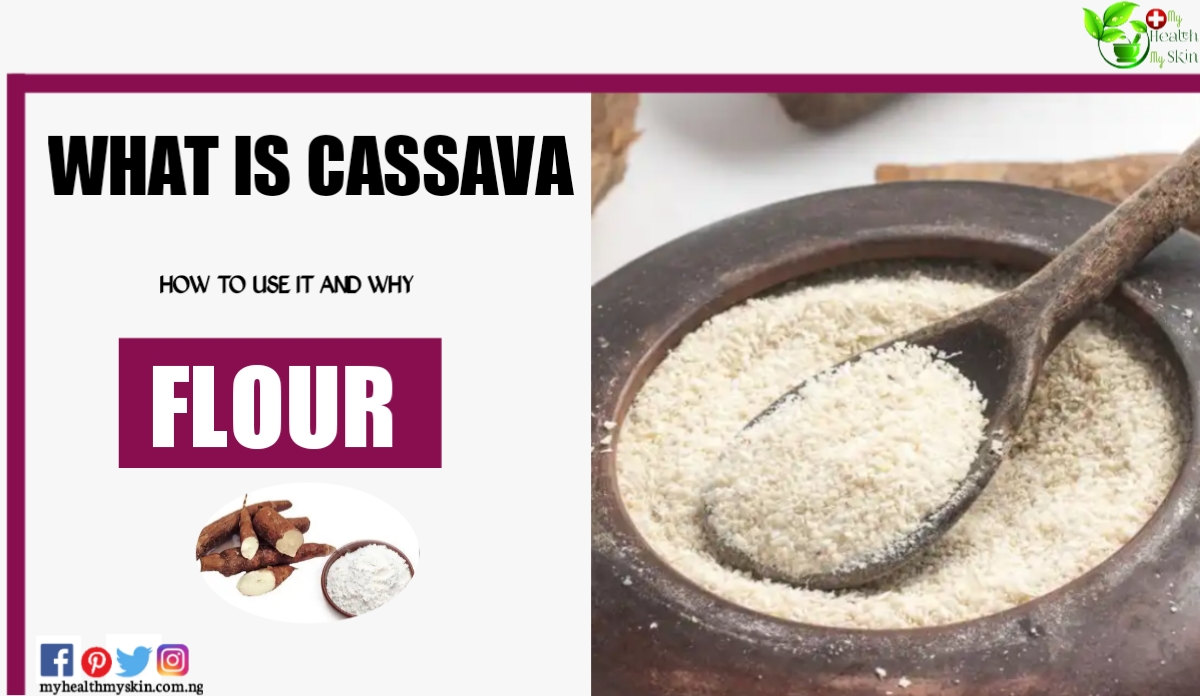What cassava flour? Cassava flour is made by grating and drying the vegetable. This flour is free from gluten, grains and nuts. Thus, it is more like white flour and may appear as a substitute for wheat flour in recipes.
It is obtained from the drying of the hydrated cassava, the cassava flour serves as a source of rapid energy and also as an alternative food for gluten-free diets.
It has a neutral flavor and is easily digestible. Furthermore, it is lower in calories than coconut or almond flour.
Cassava flour consists mainly of carbohydrates. Similar to tapioca flour , it provides resistant starch, which offers several benefits to the digestive system.
In addition, some research suggests that the resistant starch content in this flour may lower blood sugar levels and improve insulin sensitivity.
As cassava flour can be used alone in food products, it is less likely to be contaminated.
It is mostly consumed in the northern region of the country, cassava flour is a highly energetic food, which means that your consumption should be done with moderation by all those who are trying to lose a few pounds.
It is Gluten-free, there are many benefits of cassava flour for health, and also a quick power option for before the most intense workouts.
However, it is always important to note where the product was processed.
Now, we’ve read about what cassava flour, in this section we look at Cassava Nutritional Benefits.
Cassava Nutritional Benefits (medium piece):
Thus, the food originated in South America and became known under different names. But what really matters is its nutritional benefits.
Cassava is a source of vitamin C and B1, rich in potassium, fiber, folate and resveratro. In addition to being highly energetic. Here are its nutritional benefits:
Rich in iron, calcium and potassium, cassava flour is also quite caloric. A portion of 100 grams of the food contains 340 calories, 94% of which come from carbohydrates. There are therefore about 80 grams of refined carbohydrate in 100 grams of food, which makes cassava flour one of the richest carbohydrate foods we have at our disposal.
The cassava flour is also a good source of vitamin B6, manganese, magnesium and iron. Two tablespoons of flour provide 110 calories, 2.1 grams of fiber fiber, 0.5 g of proteins and 0.1 g of lipids (fats).
Now, we’ve read about what Cassava Nutritional Benefits, in this section we look at benefits of cassava flour and how to do, how to use and recipes.
Benefits of Cassava Flour – How to Do, How to Use and Recipes

Cassava, yuca or manioc is not just to make farofa (a dish of pan fried garri)that serves cassava flour – check out some of the main benefits for diet and health:
Quick energy source
Cassava flour can be a great food for anyone who needs quick energy for their activities. As it is rich in carbohydrates, cassava flour is quickly converted into glucose, the essential fuel for all the processes of the organism, such as contraction and muscle recovery.
Exactly because it is a source of rapid energy, cassava flour causes abrupt changes in glucose rates, which makes it a food to be avoided by diabetics and obese.
Promotes well-being
You may not lose weight with cassava flour, but it will surely feel better after your consumption. This is because the cassava flour is a source of tryptophan and vitamin B6, two of the nutrients needed for the production of serotonin. And what is serotonin for?
Among other functions, serotonin serves to improve mood, relieve stress, reduce the risk of depression and even combat the will to eat sweets.
Absence of fat
One of the benefits of cassava flour is the absence of fat in its composition. In a world filled with saturated fat foods, cassava flour offers a healthy option of carbohydrates and vitamins without unwanted cholesterol and saturated fats.
Source of fibre
Although not being the richest flour in fiber, the cassava flour is still a good source of the nutrient. Fibers are important because they help maintain satiety for longer and stimulate intestinal functioning. For those who are dieting, this means a better elimination of toxins and the decrease of the feared inflammation.
No-inflammation
Gluten present in wheat flour is rich in Gliadin, a protein that is not very well assimilated by our body and can cause inflammation of the intestinal wall.
In addition to being able to cause infections, this condition can lead to weight gain and even the appearance of colon cancer.
One of the benefits of cassava flour is precisely not igniting inflammation, and it can be used to treat celiac disease and all those with allergy to wheat protein.
Benefits of cassava root
Cassava or yuca? It doesn’t matter what the root is called in your own language or region. It is rich in carbohydrates and has the highest concentrations of nutrients. Officially a potato substitute, it has a softer consistency and can be served fried, boiled or soaked. The huge variety depends only on the creativity of the person who prepares it. But, do you know the benefits of cassava root? Here are the benefits of cassava root:
- Its root stores a large amount of starch,
- It is an important source of energy,
- In addition, the cassava root is rich in calcium, phosphorus and vitamin C.
- The root of cassava is used in the manufacture of flour and sprinkles, as well as being consumed in different forms, such as cooked and fried.
Now, we’ve read about the uses and benefits of cassava root, in this section we look at Cassava health Benefits and Dangers.
Cassava Benefits and Dangers
- Assists in muscle contraction
- Prevents anemia
- Helps in the absorption of nutrients in the intestine
- Improves the immune system
- Helps fight cancer
- Anti-inflammatory action
- Reduces cholesterol
- Antioxidant
- Hair strengthening
- Neutralizes eye diseases
- Finally, it improves joint movement
Cassava dangers
Consumption of raw cassava can cause cyanide poisoning. Vomiting, dizziness, nausea, stomach pains, headaches and even glottis swelling. The toxic compound is found in the bark and a cut can cause cells that release the venom to rupture.
What is the safest way to cook cassava?
The safest way is to cook the cassava before consumption and peel the root dipped in water.
How to make cassava meal at home
An advantage of making cassava flour at home is that you win, as a by-product of the flour preparation, a little cassava gum to make tapioca. Check out the recipe and the way of preparing the homemade cassava flour:
Ingredients:
- 1 kilogram of peeled and cut cassava in cubes;
- 500 ml of water.
Preparation:
1. Put all cassava in a pot, add 500 ml of water and heat;
2. Let it heat well until it has turned into a homogeneous mixture;
3. Put in a clean and dry cloth, and squeezes well to exit all excess fluid;
4. Reserve the liquid for 12 hours;
5. Transfer what remained on the cloth into a baking sheet, and spread well;
6. Bake in low preheated oven for approximately 5 hours, stirring always not to burn;
7. After drought, save the flour into a closed pot and away from moisture;
8. If you prefer a thinner flour, put it inside the processor after it has cooled.
To make the tapioca:
1. After 12 o’clock, the excess water dry. Put the gum that formed into a dry cloth. Squeeze well and transfer the mixture to a sieve;
2. With his hands, rub the dough over the sieve until a fine flour;
3. Use the flour to prepare the tapioca with the filling of your preference.
How to use
Everyone already knows that the cassava flour is great for preparing a dish of pan fried garri, but what else do you do with it? You can use it to thicken the beans, make meat-based broth, and even as partial substituted wheat flour in cakes, breads, puddings, pure, biscuits and sweets.
In the northern part of Brazil, it is quite common for consumption of cassava flour with acai berry. Although healthy, this combination is quite caloric and should be avoided by those who do not practice intense physical activity or need to lose weight.
As it is quite caloric, the ideal is not to exaggerate in quantity and not combine cassava flour with another source of carbohydrates (i.e rice with farofa or think for those who are on diet).
Recipes with cassava flour
See 3 recipes with cassava flour that are easy to do, do not contain gluten and are very tasty:
Gluten-free pancake with cassava flour
Ingredients:
- ½ cup of cassava flour;
- 1 egg;
- ½ glass of skim milk;
- 1 pinch of salt.
Preparation:
1. Heat all the ingredients with a fork and place on a non-stick frying pan with a olive oil or coconut oil;
2. Serve the pancake with your favorite filling – If you prefer the beantie pancake, replace the salt by a pinch of brown sugar.
Lite spinach soup with cassava flour
Ingredients:
- 1 cup of cassava flour;
- 1 tablespoon of olive oil;
- ½ chopped purple onion;
- 2 cups of chopped spinach;
- Salt and pepper to taste;
- 2 liters of water.
Preparation:
1. Take a pan to fire with olive oil and saute onion;
2. Add a tablespoon of cassava flour and let gold, stirring well not to burn;
3. Add the spinach and stir well;
4. Add water and boil;
5. When raising, boil and add the rest of the flour dissolved in a little water;
6. Add salt and pepper;
7. Turn off the heat
8. Serve hot.
Farofa (A dish of pan fried garri) lite with cassava meal
Ingredients:
- 250 g of cassava flour;
- 2 grated medium carrots;
- 1 Middle onion cut in very small piece;
- 2 chopped cooked light;
- 2 tablespoons of chopped green olives;
- 2 tablespoons of extra-virgin olive oil;
- 2 spoons of chopped green smell;
- Oregano and salt to taste;
- 1/2 lemon broth;
- 1 tablespoon of chia seeds.
Preparation:
Mix all the ingredients and then serve.
Does cassava makes you fat?
Cassava or Yuca is known to be high in carbohydrates, which is why it is so associated with weight gain.
However, no single food can make a person fat or lose weight: to make a difference in the balance, it has to be consumed in excess and within a diet rich in other caloric foods and rich in simple carbohydrates.
So that it is good for your health, the ideal is that yuca is part of a healthy and balanced eating plan, replacing other sources of carbohydrates such as potatoes, rice and pasta.
The ideal amount is on average 150 grams per day, but this value can vary according to your diet and lifestyle.
Where and How to buy
Anyone who thinks that only white cassava is edible is wrong: there are more than 10 types of table cassava, such as pink cassava, guaíra, tapioqueira, arari, formosa, jarí, kiriris, mulatto, golden and silver cassava. In other words, from these variations, the sweet powder is also obtained, used for several sweet and baking recipes. You can buy cassava at your local market or online market store.
When buying, check if the root has a uniform color – white or yellow, depending on the quality. But, it is never gray. So, reject the ones that have dark spots or streaks, and a secret to making them soft is to keep them immersed in the cooking water until serving.







